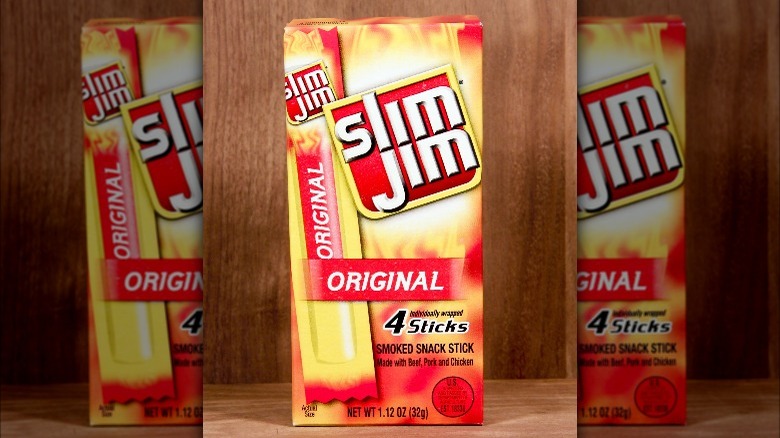The Marketing Technique That Led To The Name 'Slim Jim'
It's beefy, it's porky, and it's in the most beautiful of all shapes: the stick. The humble "Slim Jim" represents the American love of meat, portability, and of course, cowboys. Who doesn't feel like a veteran cattle rancher when chewing on this leathery log of smoky beef? But we're not here just to sing the praises of this savory snack. Indeed, there are plenty of mysteries hidden in your average Slim Jim beef stick than meets the eye.
According to Foodbeast, the Slim Jim in your kitchen cabinet is not made of synthetic mystery goo, but is actually made up of beef, pork, mechanically separated chicken, lactic acid, and corn and wheat proteins. While they may not be up there with steamed rice and activated almonds in terms of health food, you needn't worry about Slim Jims killing you any time soon, considering that you would need to eat 1,400 sticks to ingest enough sodium nitrite to poison your body (via WIRED). According to Chief Marketer, young adult men are the prime target audience for Slim Jims, which was reinforced by Randy Savage's promotion of the snack in the 1990s (via Sports Illustrated). If the Macho Man himself can dig it, so too would the world.
But how did we get a name like Slim Jim in the first place? Why not a name like Skinny Jimmy or Slender James?
The Slim Jim name was meant to sound sophisticated
If someone came up to you and offered you a Penn Rose, you'd think you were getting some kind of fancy flower. Imagine your surprise, then, when said person hands you an ordinary Slim Jim. While this may sound baffling in our time, there was a moment in history when the famed meat stick almost became known as a "Penn Rose."
As Mel Magazine explains, a 16-year-old Pennsylvanian Adolph Levis dropped out of school in 1929 to work as a self-made man, selling everything from condiments to pickled meats to taverns and delis. Levis would later partner up with his brother-in-law Joseph Cherry to develop a new kind of meat snack that would be smaller, yet just as delicious as large sausages like pepperoni. The original product, the first dried beef sticks, were actually labeled as "Penn Roses" — named after the state of Pennsylvania and Levis' wife Rose.
But the name Penn Rose didn't stick, leaving Levis and Cherry back at square one. According to Thrillist, perhaps taking inspiration from the "sophisticated" brand of cigarettes known as Virginia Slims, Levis dubbed his new bar snack "Slim Jims" as a way to market them as a mature, respectable type of snack for the discerning patron. After all, a man with a Slim Jim and a glass of beer would appear more classy and masculine to the average bargoer.
Fancy name aside, how else could such a snack appeal to patrons?
What makes Slim Jims so popular?
When it all comes down to it, a Slim Jim is pretty basic: It's a stick of meat. At first glance, the only difference you can gather between it and your average beef jerky is the shape. How exactly can something as simple as a Slim Jim become so popular? The reasons are many, ranging from impressive marketing to the fact that they are, relatively speaking, somewhat healthy for you.
In the case of marketing, you'll remember we mentioned Macho Man Randy Savage earlier in the article. The use of Mr. Savage and his extreme attitude is only one of the many unique and aggressive styles of marketing Slim Jim uses to move its product. Better Marketing tells us that Slim Jim's Instagram account is filled with nonsensical, surreal, and hysterical (at least to a certain audience) memes, including but not limited to calling itself part of the "Long Boi Gang" of meat products. It is this diversion of out-of-touch corporate advertising or trying to be something that it isn't that helps set it apart. It's edgy, it's wild, and it stands out from the crowd (via Finden Marketing), so it just works.
But what about Slim Jims being healthy for you? While we don't advise you to go and bulk up on Slim Jims like they're the next health food, they do contain a pretty decent amount of protein, although this is mitigated somewhat by the fact that they are full of preservatives.


